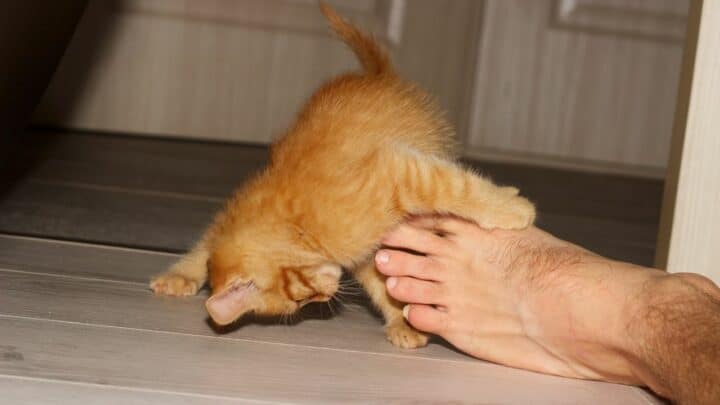If you’re a cat owner, you’ve more than likely experienced the unbridled terror that comes with having a miniature set of fangs embed themselves in your ankle.
Cats can be mischievous creatures, and this naughty habit is a testament to that.
Needless to say, there are reasons for these sneak attacks that are actually entirely natural, mostly innocent, and relatively sweet.
Read on to find out why our feline friends like to snack on our ankles.
Why do cats bite ankles?
One of the reasons cats bite ankles is because feet are sized and move like prey. Similarly, they may think it’s playtime if they see their owner’s feet shuffling. Other reasons for ankle-biting may be that a cat is looking for attention or trying to communicate something to its human.
Why Cats Bite Ankles
Contrary to what some people may believe, cats rarely attack ankles out of aggression.
These beautiful beasts are natural hunters, and unfortunately for cat owners, human feet are roughly the size and shape of small animals.
Therefore, your cat may be using your feet as target practice for their hunting skills.
Alternatively, the shuffling of human feet may strike a cat as an invitation to play.
Owners are bound to react when they have their ankles swatted, so in a feline’s mind, this could look like the owner is engaged in the game, further encouraging it.
In either case, cats biting at ankles may show that they have excess energy that needs exerting.
Cats are more active than we are led to believe and require a fair amount of entertainment which they will often undertake to create for themselves if their needs are not met.
Reason 1: Cat Biting Ankles For Attention
Cats occasionally bite their owner’s ankles to get their attention or even show them affection.
One often sees cats who live together or who are bonded grooming and gently biting one another.
Although less pleasant for human skin, take it as a compliment that a kitty may just be showing you some love, especially if purrs and rubs accompany bites.
On the other hand, there is also a chance that a cat is trying to communicate something through biting.
They may be trying to indicate that they’re hungry, particularly if biting occurs around mealtimes.
Cats are also known to sometimes nip at ankles if they’ve had enough of their owner petting or playing with them.
Looking at what their tails are doing will assist with figuring out what their mood is like and if their biting is playful or dismissive.
Reason 2: Cat Biting Ankles For Medical Reasons
Occasionally, cats biting at their owners’ ankles can stem from a medical condition known as hyperthyroidism, which causes an imbalance of hormones in older felines.
A common symptom of hyperthyroidism is extreme restlessness which can manifest in ankle-biting.
In this case, a cat is likely trying to tell its owner that it is not feeling well. Other symptoms include extraordinary thirst, intermittent vomiting, and diarrhea.
If a feline displays any of the symptoms mentioned, it needs to see a vet as soon as possible.
Furthermore, studies have shown that cats may even bite their owner’s ankles for psychological reasons.
If a cat loses access to its mother and siblings at too young an age, it might just not know when its playfulness becomes too aggressive.
How To Prevent My Cat From Biting My Ankles
Cats will be cats, but there are a few preventative measures you can put in place if your cat is too avid an ankle-biter.
For one, owners should try their best not to react if their cat attack their ankles.
Squealing and jumping about is the exact reaction a cat is looking for, and this lets them believe that the human is into the game.
Secondly, if you know your cat has a habit of waiting around the corner for you, trying to catch them off guard by tossing them a toy upfront may distract them for long enough to leave you alone.
Frequently Asked Questions About Why Cats Bite Ankles
How do I know if my cat’s behavior is aggressive?
Cats can be play-aggressive or real aggressive, and the difference is easy to spot. Play aggression may entail it chasing you or biting at you. Real aggression is usually accompanied by growling, spitting, hissing, or tail lashing.
What type of play should I avoid with my cat?
If you don’t want your cat to attack your hands and feet, it’s best to teach them from the get-go that these are not acceptable playthings. Discourage hand and foot biting by distracting them with suitable toys. Never swat at or yell at a cat when they bite your limbs, as this may turn their play aggression into real aggression, or worse, make them scared of you. Squirting them with a water bottle is a better and safer deterrent.
How can I keep my cat entertained?
There are endless specially designed products available with which to entertain cats. Interactive toys, puzzle feeders, soft toys – even boxes – are all good options with which to keep your kitty stimulated. The thing to remember is that these animals need an outlet for their energy, and as their human, it is your job to provide them with a stimulating living environment.
Conclusion
Cats have a reputation for being cheeky, and there’s a good reason for it.
Don’t underestimate how much they might enjoy watching you react to a little chomp at your ankles.
For the most part, however, this behavior is harmless, and to be honest, they probably sit back and wonder what all the fuss is about.
Do female cats spray when in heat? – Read this interesting article now!


